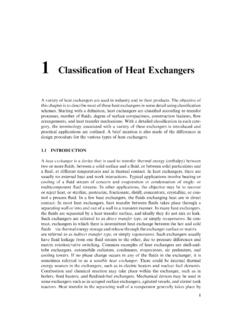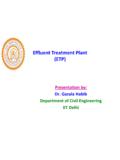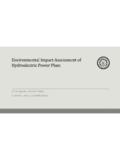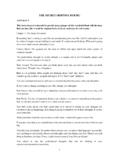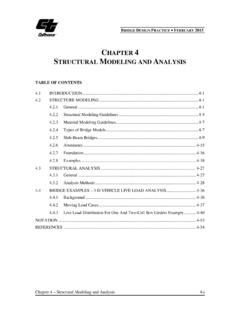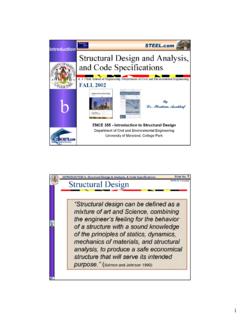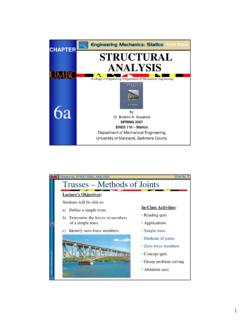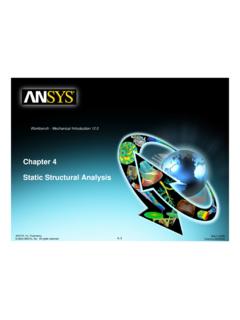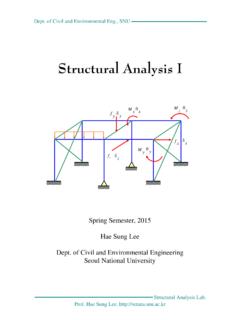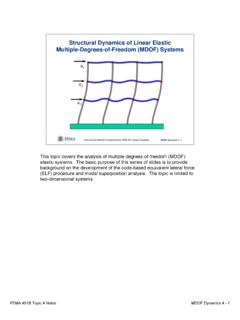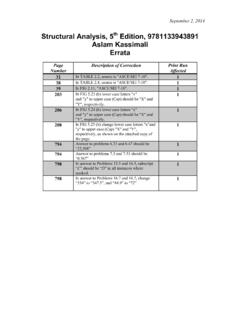Transcription of STRUCTURAL ANALYSIS-II - web.iitd.ac.in
1 Page 1 COURSE TEMPLATE 1. Department/Centre proposing the course CIVIL ENGINEERING 2. Course Title (< 45 characters) STRUCTURAL ANALYSIS-II 3. L-T-P structure 3-0-0 4. Credits 3 5. Course number 6. Status (category for program) CORE 7. Pre-requisites (course ) STRUCTURAL analysis -I 8. Status vis- -vis other courses (give course number/title) Overlap with any UG/PG course of the NO Overlap with any UG/PG course of other NO Supercedes any existing course NO 9.
2 Not allowed for (indicate program names) NA 10. Frequency of offering Every sem 1st sem 2nd sem Either sem 11. Faculty who will teach the course 12. Will the course require any visiting faculty? NO 13. Course objective (about 50 words): To develop knowledge on the analysis of indeterminate structures 14. Course contents (about 100 words) (Include laboratory/design activities): Determinacy and stability; Method of consistent deformations-Matrix formulation, Application to beams, trusses and frames; Slope-deflection method and Moment-distribution method- Beams and frames with uneven loading, support settlements, dealing with symmetry and anti-symmetry, Non-sway and sway frames; Matrix stiffness method; Matrix flexibility method; Energy methods; Approximate methods of analysis .
3 Direct stiffness method for computer applications including computational aspects and MATLAB Assignments Page 2 15. Lecture Outline (with topics and number of lectures) Module no. Topic No. of hours 1 Stability and determinacy-Static and Kinematic 3 2 Method of consistent deformations-Development and application to beams, trusses and frames 4 3 Slope-deflection method-Development and application to beams and frames 8 4 Moment-distribution method 6 5 Matrix stiffness method 6 6 Matrix flexibility method 6 7 Energy methods 3 8 Approximate methods of analysis .
4 2 9 Direct stiffness method for computer applications 4 10 11 12 COURSE TOTAL (14 times L ) 42 16. Brief description of tutorial activities 17. Brief description of laboratory activities Moduleno. Experiment description No. of hours 1 2 3 4 5 6 7 8 9 10 COURSE TOTAL (14 times P ) 18.
5 Suggested texts and reference materials STYLE: Author name and initials, Title, Edition, Publisher, Year. Wang, C. K., (1952), Indeterminate STRUCTURAL analysis , Tata McGraw Hill Publishing. Yuan Yu Hsieh, (1987), Elementary Theory of Structures, 3rd edition, Prentice Hall. Hibbeller, R. C., (2002), STRUCTURAL analysis , 6th Edition, Pearson Education. Kinney, , Indeterminate STRUCTURAL analysis ,Oxford IBH Publishing Company. Reddy, C. S., Basic STRUCTURAL analysis , Tata McGraw Hill Publishing. Ghali, A.
6 And Neville, A. M., (2003), STRUCTURAL analysis (Unified Classical and Matrix Approach), 5th Edition, Chapman and Hall, Ltd. 19. Resources required for the course (itemized & student access requirements, if any) Page 3 Software Hardware Teaching aides (videos, etc.) Laboratory Equipment Classroom infrastructure Site visits 20. Design content of the course (Percent of student time with examples, if possible) Design-type problems Open-ended problems Project-type activity Open-ended laboratory work Others (please specify) Date: (Signature of the Head of the Department) Page 1 COURSE TEMPLATE 1.
7 Department/Centre proposing the course Civil Engineering 2. Course Title (< 45 characters) REINFORCED CONCRETE DESIGN 3. L-T-P structure 3-0-0 4. Credits 3 5. Course number 6. Status (category for program) Core 7. Pre-requisites (course ) None 8. Status vis- -vis other courses (give course number/title) Overlap with any UG/PG course of the No Overlap with any UG/PG course of other No Supercedes any existing course No 9. Not allowed for (indicate program names) NA 10.
8 Frequency of offering Every sem 1st sem 2nd sem Either sem 11. Faculty who will teach the course 12. Will the course require any visiting faculty? 13. Course objective (about 50 words): To develop knowledge on the basic design principles of concrete structures based on design standards 14. Course contents (about 100 words) (Include laboratory/design activities): Design Philosophy: Working stress and limit state design concepts; Design of and detailing of RC beam sections in flexure, shear, torsion and bond; Design for serviceability; Design of RC beams, One way and two way RC slabs, RC short and long columns, RC footings.
9 Page 2 15. Lecture Outline (with topics and number of lectures) Module no. Topic No. of hours 1 Design philosophy - Working stress and limit state methods 2 2 Desing of RC beam sections for flexure using working stress method 3 3 Design of RC beam sections for flexure, shear and torsion using limit state methods 9 4 Design of RC beam elements - detailing, curtailment and serviceability 4 5 Design of one way slabs, design of two-way slabs, design of slabs for serviceability.
10 Design of continuous slab systems 6 6 Design of short columns under pure compression, design of short columns under compression, and uniaxial and biaxial bending 8 7 Design of long columns 5 8 Principles of STRUCTURAL design of footings, design of isolated RC footings 5 9 10 11 12 COURSE TOTAL (14 times L ) 42 16. Brief description of tutorial activities 17.


